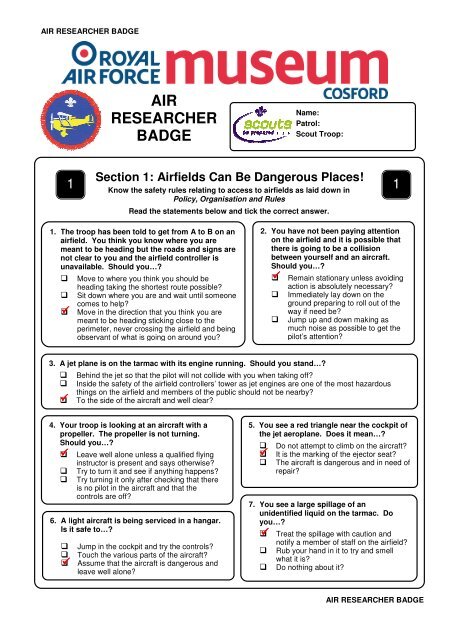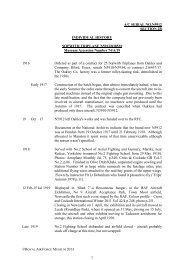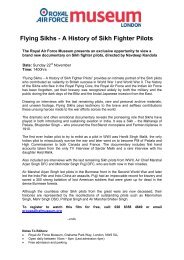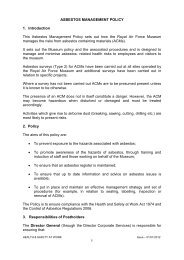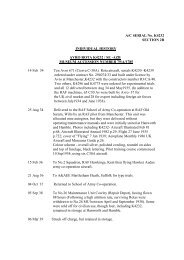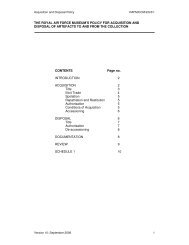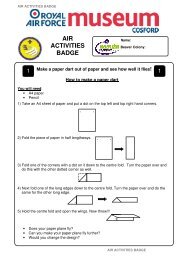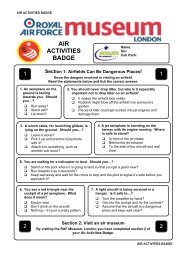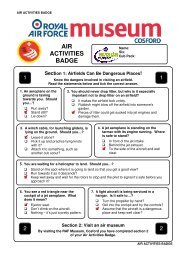Download Air Researcher Badge Worksheet Answers
Download Air Researcher Badge Worksheet Answers
Download Air Researcher Badge Worksheet Answers
You also want an ePaper? Increase the reach of your titles
YUMPU automatically turns print PDFs into web optimized ePapers that Google loves.
AIR RESEARCHER BADGE<br />
AIR<br />
RESEARCHER<br />
BADGE<br />
Name:<br />
Patrol:<br />
Scout Troop:<br />
Section 1: <strong>Air</strong>fields Can Be Dangerous Places!<br />
1 1<br />
Know the safety rules relating to access to airfields as laid down in<br />
Policy, Organisation and Rules<br />
Read the statements below and tick the correct answer.<br />
1. The troop has been told to get from A to B on an<br />
airfield. You think you know where you are<br />
meant to be heading but the roads and signs are<br />
not clear to you and the airfield controller is<br />
unavailable. Should you…?<br />
Move to where you think you should be<br />
heading taking the shortest route possible?<br />
Sit down where you are and wait until someone<br />
comes to help?<br />
Move in the direction that you think you are<br />
meant to be heading sticking close to the<br />
perimeter, never crossing the airfield and being<br />
observant of what is going on around you?<br />
2. You have not been paying attention<br />
on the airfield and it is possible that<br />
there is going to be a collision<br />
between yourself and an aircraft.<br />
Should you…?<br />
Remain stationary unless avoiding<br />
action is absolutely necessary?<br />
Immediately lay down on the<br />
ground preparing to roll out of the<br />
way if need be?<br />
Jump up and down making as<br />
much noise as possible to get the<br />
pilot’s attention?<br />
3. A jet plane is on the tarmac with its engine running. Should you stand…?<br />
Behind the jet so that the pilot will not collide with you when taking off?<br />
Inside the safety of the airfield controllers’ tower as jet engines are one of the most hazardous<br />
things on the airfield and members of the public should not be nearby?<br />
To the side of the aircraft and well clear?<br />
4. Your troop is looking at an aircraft with a<br />
propeller. The propeller is not turning.<br />
Should you…?<br />
Leave well alone unless a qualified flying<br />
instructor is present and says otherwise?<br />
Try to turn it and see if anything happens?<br />
Try turning it only after checking that there<br />
is no pilot in the aircraft and that the<br />
controls are off?<br />
6. A light aircraft is being serviced in a hangar.<br />
Is it safe to…?<br />
Jump in the cockpit and try the controls?<br />
Touch the various parts of the aircraft?<br />
Assume that the aircraft is dangerous and<br />
leave well alone?<br />
5. You see a red triangle near the cockpit of<br />
the jet aeroplane. Does it mean…?<br />
Do not attempt to climb on the aircraft?<br />
It is the marking of the ejector seat?<br />
The aircraft is dangerous and in need of<br />
repair?<br />
7. You see a large spillage of an<br />
unidentified liquid on the tarmac. Do<br />
you…?<br />
Treat the spillage with caution and<br />
notify a member of staff on the airfield?<br />
Rub your hand in it to try and smell<br />
what it is?<br />
Do nothing about it?<br />
AIR RESEARCHER BADGE
AIR RESEARCHER BADGE<br />
2e<br />
Section 2e: Rolls Royce Engines<br />
Carry out research into the development of a type of aero engine.<br />
2e<br />
Rolls Royce engines are a good example for your research.<br />
Rolls Royce engines were used in the Spitfire and the Hurricane, two of the most memorable<br />
aeroplanes to enter service with the Royal <strong>Air</strong> Force during World War Two.<br />
Before<br />
your<br />
Visit!!!<br />
You should do your own research prior to visiting the museum. When researching you will<br />
need to know some facts, but you need to come up with your own thoughts not somebody<br />
else’s! There are many books and websites about aero engines, including our own at<br />
www.rafmuseum.org and http://navigator.rafmuseum.org. When you visit the museum you<br />
can study the engines and aircraft up close using our caption boards. This way you will really<br />
have your own ideas and conclusions enabling you to answer the worksheet - You may even<br />
become an expert! You will be researching the development of In-line engines made by Rolls<br />
Royce. These Take a are good just look one at type both of piston engines; engine. do you At the have museum a favourite? you can also see other<br />
types of piston Think engines, about as your well as own lots impression of jet engines. of each engine.<br />
Take a good look at both of the following engines do you have a favourite?<br />
Think about your own impression of each engine and make notes in the boxes below.<br />
Rolls Royce Kestrel<br />
(War Planes)<br />
Rolls Royce Merlin<br />
(Hangar 1)<br />
.<br />
Compare<br />
and<br />
Contrast<br />
Don’t forget you will need to share your findings with the assessor and other scouts!<br />
AIR RESEARCHER BADGE
AIR RESEARCHER BADGE<br />
To help you understand the developments between the two engines it will be useful to look at<br />
examples of the aircraft which used them. Whilst looking at the aircraft note down some of the<br />
facts on the caption boards. The first thing you will need to find out is which engine was used in<br />
which plane.<br />
The better aeroplane?<br />
Hawker Hind<br />
(Hangar 3)<br />
Spitfire MK1<br />
(Hangar 3)<br />
Compare<br />
and<br />
Contrast<br />
Type: Two – seat light bomber<br />
Type: Single – seat fighter<br />
In–Service: 1935 - 1943 In-Service: 1938 - 1945<br />
Maximum Speed: 300km/h at 5,000m Maximum Speed: 570 km/h at 5,790m<br />
Engine: 640 hp Rolls-Royce Kestrel V<br />
Armament: One Vickers 0.303 in (7.7mm) machine gun<br />
forward and one Lewis 0.303 in (7.7mm) machine gun aft.<br />
Engine: 1030hp Rolls Royce Merlin II or III<br />
Armament: Eight 0.303 in (7.7mm) machine<br />
guns in the wings.<br />
Fill in the Gaps<br />
• The Hind was a development of the Hart light bomber.<br />
• The prototype of the Hind was flown in 1934 and issued to the front line just fifteen months later.<br />
• The Hind was the Royal <strong>Air</strong> Force’s last biplane light bomber.<br />
• In 1939 the Hind was withdrawn and replaced by more advanced aeroplanes.<br />
• The Spitfire was both popular and famous and is still one of the most well known aircraft today.<br />
• The prototype Spitfire made its first flight in 1936.<br />
• In August 1938 the Spitfire entered service with No. 19 Squadron.<br />
• By the time of the Battle of Britain there were 19 Spitfire I squadrons available.<br />
To<br />
Complete<br />
Your<br />
<strong>Badge</strong><br />
By visiting the museum you have completed Section 3.<br />
For Section 4 you will need to present your findings, you need to<br />
make a model to illustrate some aspect of your research.<br />
Consider using diagrams and other resource materials to illustrate your<br />
presentation. You will find many things including pictures, books, videos<br />
and models in our Museum Shop to help with your presentation.<br />
Sections<br />
3 & 4<br />
AIR RESEARCHER BADGE


